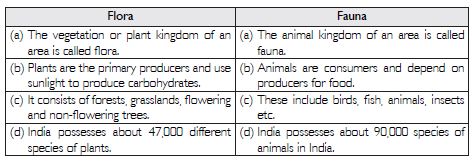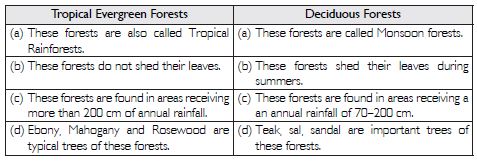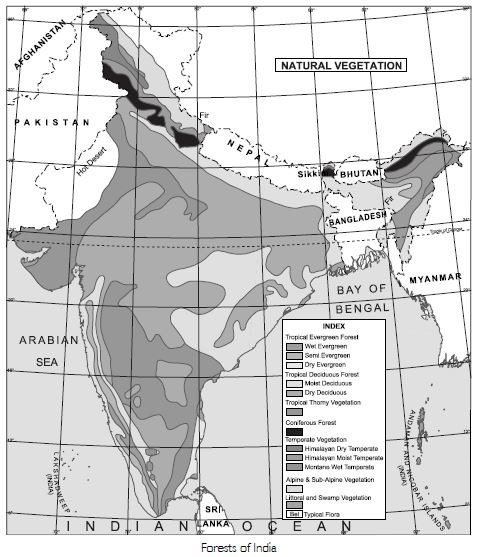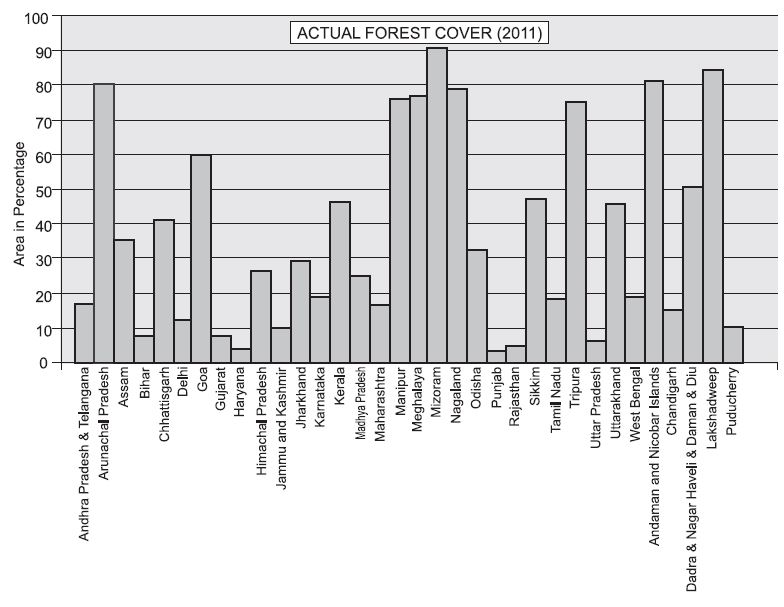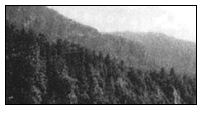Question 1:
To which one of the following types of vegetation does rubber belong to?
- Tundra
- Tidal
- Himalayan
- Tropical evergreen.
Answer:
(d) Tropical evergreen.
Question 2:
Cinchona trees are found in the areas of rainfall more than:
- 100 cm
- 50 cm
- 70 cm
- Less than 50 cm
Answer:
(a) 100 cm
Question 3:
In which one of the following states is the Simlipal Bio-reserve located?
- Punjab
- Delhi
- Odisha
- West Bengal.
Answer:
(c) Odisha
Question 4:
Which one of the following bio-reserves of India is not included in the world network of Bioreserves?
- Manas
- Nilgiri
- Gulf of Mannar
- Nanda Devi.
Answer:
(a) Manas
Question 5:
What factors are responsible for the distribution of plants and animals in India?
Answer:
The distribution of plants and animals is determined primarily by the following factors:
(a) Climate
(b) Soil
(c) Relief
(d) Drainage.
Question 6:
What is a bio-reserve? Give two examples.
Answer:
There is a great biological diversity of our land. Vast areas have been reserved for the preservation and protection of flora and fauna of the country in their natural form. Such areas are called Bio-reserves. In these areas, natural plants and animals are protected for the use of future generations. The first biosphere in India was set up at Nilgiri covering an area of 5520 sq. km. Another biosphere was set up at Nanda Devi in Uttarakhand.
Question 7:
Name two animals having habitat in tropical and montane type of vegetation.
Answer:
Tropical—Tiger
Montane—Yak
Question 8:
Distinguish between:
Flora and Fauna.
Answer:
Question 9:
Distinguish between:
Tropical Evergreen and Deciduous Forests.
Answer:
Question 10:
Name different types of vegetation found in India and describe the vegetation of high altitudes.
Answer:
Types of Forests: Due to variation in rainfall, temperature and altitude, there is great variety of natural vegetation in India. The following different types of forests are found in India:
(i) The Tropical Rainforests: These forests are found in areas where annual rainfall is more
than
200 cms and the mean temperature is more than 20°C. These forests are found in western
parts of the Western Ghats, Plains of West Bengal, Odisha, Eastern Himalayas and the Andaman
Islands.
(ii) The Monsoon or Tropical Deciduous Forests: These forests are found in the areas where
rainfall is between 70 cm and 200 cm. These trees shed their leaves in the hot dry season.
So these are called deciduous forests. These forests are found in Terai, Chhotanagpur
Plateau (Jharkhand and Chhattisgarh): eastern slopes of the Western Ghats and eastern part
of
peninsular India. These are not dense forests.
(iii) Thorn Forests and Scrubs: These forests grow where the annual rainfall is less than 70
cm.
These are found in parts of eastern Rajasthan, Saurashtra, Malwa Plateau (M.P.), Southern
Haryana, S.W. Uttar Pradesh and the Karnataka Plateau.
(iv) The Tidal Forests: These forests are found in deltas of rivers in the coastal areas.
These are
called Tidal forests of Deltaic forests. These forests are found in Ganga—Brahmaputra Delta,
Delta of Mahanadi, Godavari, Krishna and Kaveri. These are marshy areas. In West Bengal, the
the Ganga and Brahmaputra forms a delta, the forests here are called Sundarbans because the
Sundari trees are found in this area.
(v) Montane Forests: The vegetation varies from temperate forests to temperate grasslands
followed by Alpine vegetation to Tundra vegetation. These are found in the Himalayan states
like Jammu and Kashmir, Himachal Pradesh, Uttrakhand and Sikkim. The common trees found
in Montane forests include Oaks, Pine, Deodar, silver fir, mosses and lichens, etc.
Question 11:
Quite a few species of plants and animals are ‘endangered' in India. Why?
Answer:
India has a diversity of wild animals, but many rare species have become extinct in India.
The two
examples of endangered species are the one-horned rhinos and the Great Indian Bustard.
Biosphere reserves are vast areas established for the preservation of wild animals. These
reserves
are used for the protection of rare species of animals found in India. Wildlife is a natural
resource.
It is conserved for the use of future generations.
Question 12:
Why does India have a rich heritage of flora and fauna?
Answer:
Vegetation has a close relation with the environment. India has varied relief, landforms,
terrain, soil
types and climatic conditions (temperature and rainfall). As a result, a great variety of
flora is found
in India. India possesses about 47,000 different species of plants. Nearly 5000 species are
found
exclusively in India, out of which, 40% of them are exotic plants.
In the Himalayan region, the vegetation varies according to altitude ranging from tropical
forests to
Alpine grasslands. The country is rich in flowering plants according to the duration of the
growing
season. India is rich in non-flowering plants like ferns, algae and fungi. Natural
vegetation varies
according to the amount of summer rainfall ranging from tropical rainforest, monsoon forests
and
dry forests. The natural vegetation varies as forests, grasslands and scrubs as the rainfall
decreases.
Thus, India has a diverse flora.
Question 13:
Why are the southern slopes in Himalayan region covered with thick vegetation cover as compared to northern slopes of the same hills?
Answer:
The southern slopes of the Himalayan region receive heavy rainfall, which helps in the growth of vegetation quickly. The soil here is also suitable for the growth of vegetation. On the other hand, northern slopes of the Himalayas always remain covered with snow due to high altitude.
Question 14:
Why have the western slopes of the Western Ghats covered with thick forests and not the eastern slopes?
Answer:
The western slopes of the western ghats covered with thick forest because they receive more
than
300 cms of rainfall annually. It helps in the growth of thick forests here.
The eastern slopes of the western ghats lies in a rain shadow area. This region receive
scanty rainfall.
Hence, plant (vegetation) growth is very thin here.
Question 15:
Study the bar graph and answer the following questions.
(i) Name the state having maximum area under forest cover.
(ii) Name the union territory having minimum area under forest cover and why?
Answer:
(i) Arunachal Pradesh, Manipur, Mizoram, Nagaland, Sikkim, Meghalaya and Tripura.
(ii) Delhi, Puducherry and Chandigarh.
Question 16:
Activity: Study the given map for the forest cover and try to find the reasons as to why certain states have more area under forest as compared to others?
Answer:
According to the map and the table given of area under forest, there are various reasons as
to why
certain states have low and certain areas have high area of forest cover.
(i) State of Development: North-eastern states like Arunachal Pradesh, Manipur, Mizoram,
Nagaland, Sikkim, Meghalaya and Tripura along with the island states of Andaman and Nicobar
islands and the Lakshadweep islands have a large number of area under forest cover as these
states have a low level of development.
(ii) Agriculturally dominant: States like Haryana, Punjab, Bihar and Uttar Pradesh are
agriculturally
dominant states. Forest cover has been cut down to facilitate the growing of crops.
(iii) Infrastructure: States like Maharashtra, Delhi, West Bengal, Tamil Nadu, Karnataka,
Telangana,
Andhra Pradesh and Odisha have low forest cover as the level of infrastructure is very high.
These states offer world class amenities along with well developed transport system.
(iv) Rugged Terrain: Union territory of Ladakh, Himachal Pradesh, Uttarakhand, along with
the
North-eastern states have high forest cover as these have rugged terrain. Agriculture is
less
developed and the construction of transport facilities is not possible.
Question 17:
Can you identify the type of forest shown in this picture?
Identify some tree in it. What type of similarity / dissimilarity you
notice in this type of vegetation from the one found in your region?
Answer:
These are mountain forests. Important trees of these forests are Pine, Deodor, Silver Fir and Cedar.
Question 18:
Activity
(i) Find out from the above newspaper cuttings, the main concern highlighted in the given
news items.
(ii) Collect more information about various endangered species from newspapers and
magazines.
(iii) Find out various steps taken by the Indian government to protect them.
Answer:
(i) Dwindling of wildlife species.
(ii) Duck, Indian vulture, Himalayan Quail, Great Indian Bustard, Gundia Indian Frog,
Himalayan
Wolf, Javan Rhinoceros, Indian Dolphin, Pink-Headed-duck, Indian Rhinoceros and Black
Buck.
(iii) (a) Government has as set up bio-reserve.
(b) 89 National parks and 490 wildlife sancturies have been opened to preserve forests
animals.
(c) Zoological gardens have been set up to take care of natural heritage.

